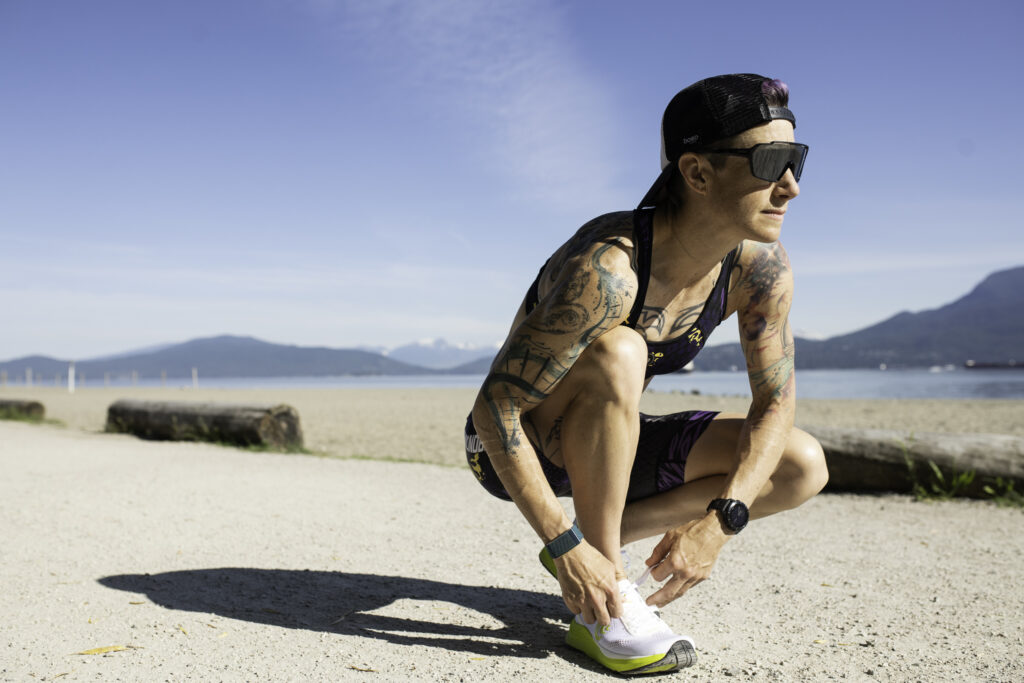
In celebration of International Non-binary Awareness Week, we caught up with the “Purple Tiger” Rach McBride (they/them), the world’s first out non-binary pro triathlete. It’s been a full year since Rach has been able to bravely show their stripes in the professional athlete world and, while there is much more work to be done, so much has changed since June 2020 (publishing date of original post).
In April, you were featured in Sports Illustrated, what did that mean to you!? What did it mean to non-binary athletes and the sports you compete in?
I mean, talk about something I never even imagined would be happening to me! The SI article to me really shows how mainstream this conversation is becoming. It is a recognition that sport is just going to have to take into account athletes who identify outside the binary. We athletes are here, now how do we fit in? How can we make sport a more inclusive space for all people? The gender piece is just one small part of this wonderful world of inclusion!
What are your favorite interviews that you’ve done so far in the last year on this topic?
Oh gosh, there have been so many! It’s really hard to choose. Everyone I’ve spoken to has just been incredible, and I love connecting with fascinating folks who are taking the initiative to tell these important stories. If I had to pick, one of my favs would definitely be the Inside Tri Show.
What interviews have you listened to/personalities you have followed that have resonated with you this past year?
The BBC podcast NB: My Nonbinary Life seriously resonated with me. Hosted by Caitlin Benedict & Amrou Al-Kadhi, this 8-episode series explored ideas and questions that I have been tackling all my life. It was so validating to listen especially to some of Caitlin’s experiences that really normalized some of the things I’d been struggling with. I also learned so much about other people’s journeys through their non-binary identities. An all-around, excellent listen!
What has the reception been like since coming out as non-binary last year? What positive experiences have you had since sharing your non-binary identity? What challenges do you still face?
The reception has been overwhelmingly positive – if there has been any negative chatter, I have not been privy and I’m grateful for that. I have been graced with such an incredible platform to become an out advocate for non-binary athletes and folks in general. It definitely requires a lot of energy, but I am so happy to take that on. The biggest public challenge I face is the daily struggle with being misgendered. Particularly in race scenarios, incorrect pronouns or gendered language is still something I hear every day.
In my personal life, I’ve been sitting more in my own feelings of gender dysphoria. This has led to some self-exploration about how I see myself in the world, what I want my body to look like, what features are gender euphoric and how do I support and reinforce this gender euphoria.
What challenges do non-binary athletes continue to have in sport? What progress has been made thus far? What do you hope will change 5 years from now? 10 years?
I think the pandemic has helped progress in the inclusion of nonbinary athletes in sport. In general, especially in North America, inclusivity on all fronts has become unignorable. We have seen many races adding non-binary categories, including prize money in some cases. Organizations have been allowed a year of no events to reconsider how they can be more inclusive. That being said, non-binary athletes continue to have challenges being seen, validated and included – for example, through the continued use of gendered language and assumed pronouns.
What can athletic/outdoor brands do to be more inclusive of non-binary athletes?
Aside from increasing visibility by profiling and including gender-diverse folks in branding, ads, social media, etc., marketing clothing and shoes in a gender-inclusive way would create space for people of all genders to have a more comfortable shopping experience. Clothing and shoes should be able to be worn by people of any gender. Who says that a dress is only for women-identified humans?!
What do you think are some of the most common misconceptions that still exist today about people/athletes that identify as non-binary?
There are a few misconceptions that I think are the most common:
- Using they/them pronouns is grammatically incorrect.
- Not all nonbinary folks use they/them pronouns.
- Nonbinary and gender diverse people are just looking for attention.
You have been identified as being only one of three openly nonbinary athletes competing professionally in North American sports – do believe that’s true?
Not anymore! I do know that Pro runner Nikki Hiltz just came out as nonbinary so I think there are plenty more that will become visible. This is just the tip of the iceberg!

Rach McBride (they/ them) is a 43-year-old professional triathlete from Vancouver, BC. They have been racing triathlon for over a decade. Follow “the most interesting [person] in triathlon” on Instagram @rachelmcb, especially as they gear up for the Ironman World Championships Kona on October 9!